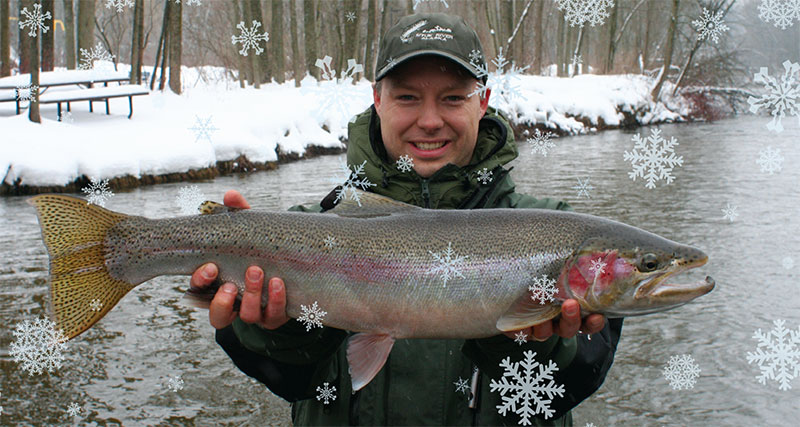
Extend your Great Lakes fishing season.
’Twas a calm, cold and eerie night on Lake Erie, four days before Christmas. Three of us
had launched in a big walleye boat in Huron, Ohio, a couple hours after sunset and it was now past midnight — dark and perfectly still, a slight haze blurring the stars.
The 15-hp kicker motor hummed quietly and pushed us just fast enough to make the array of curved Reef Runner minnow baits wobble and dive. We had six of them out, three on each side of the boat, each lure behind an online planer board that carried a luminous glow stick, each board creating a minuscule wake.
This was the mid-1990s when the abundance of Lake Erie walleye prompted the Ohio fish authorities to set the daily limit of fish at 10 per angler. My friend, pro walleye fisherman Mark Brumbaugh, was determined that the three of us would fill that limit; at around 1 a.m., we had 26 and needed four more to put 30 in the crammed livewell.
The big walleyes had been snapping, providing consistent action as we caught fish after fish, watching the little glow stick lights sweep back whenever a toothy maw grabbed a lure. But we had hit a major lull, without action for almost two hours.
That’s when the phantom fish started biting.
Every five minutes or so, one of the planer boards would stall and fall behind the others, but when we’d grab the rod to reel in what we thought was a fish, nothing was there but the lure. This happened six or seven times before we realized skim ice was forming and delicately crunching into the boards, creating a perfect illusion that fish were still biting. I was glad when Brumbaugh finally called it a night and we headed back toward warm motel rooms. We would clean fish — lots of fish — in the morning.
The fact is, some of the best fishing for walleye, salmon, trout, whitefish and even yellow perch occurs when saner anglers have already stored their boats for the winter.
But, you must be careful when using your boat in below-freezing temperatures. Here are some nuggets of advice to spare your ride while cashing in on terrific fishing.
Cold-weather fishing tips
Once you’re off the lake, water becoming ice is your enemy. After you put your boat on the trailer, park on level ground and trim your outboard down so water drains from the cooling system. Remove your shut-off switch and crank the motor a couple of times to clear the water pump.
Don’t forget to drain livewells and take out your drain plug to clear water from your bilge and bilge pumps, which can crack when ice forms inside. Take along a spare, portable electric bilge pump for a cold-water emergency.
When launching with a trailer that has carpeted bunks, don’t unhook the winch strap until your boat is in the water. Boats easily slip off frozen bunks and few sights and sounds are as sickening as a lower unit and hull sliding down a concrete ramp.
Popular ramps ice up quickly when anglers launch boats and pull dripping trailers back up. Take along a couple bags of kitty litter or 5-gallon buckets of sand to put under tires for traction on ice. A tow strap can let a good Samaritan pull your tow vehicle and trailer up slick ramps.
On a multi-day trip, cover your trailer boat at night and run an extension cord with a service light and an incandescent bulb underneath. This can create enough overnight warmth to keep rod lockers and livewell lids from freezing shut. Propping lids slightly open with rags overnight also keeps them from sealing closed.
Finally, make friends with a guy who tows his boat with a truck equipped with a snow plow blade. Caravan over to your fishing spot with him and bring your own shovel to help him clear ice and snow from the launch.
The fishing during cold weather can be so good it’s worth the extra effort.






